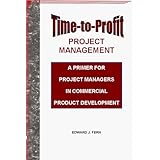
Average Reviews:

(More customer reviews)Time-to-Profit Project Management: A Primer for Project Managers in Commercial Product Development
Reviewed by David S. Jacob, Principal, Doren Associates, President PMI-Orange County Chapter
To borrow a thought from the CEO of Microsoft soon-to-be published latest book, Bill Gates' New Rules, "If the 1980s were about quality and the 1990s were about re-engineering, then the 2000s will be about velocity." - then Edward Fern's new book, "Time-to-Profit Project Management", is a "must-read" for project managers who aspire to lead and rapidly deliver successful product development projects in the next millennium.
Mr. Fern has placed a new perspective on the word "profit", by infusing it with a non-traditional meaning. As he points out, "profit is the total benefit that a company receives from its customers in exchange for the value it delivers to them. In this context "profit" is not merely the traditional measure of the difference between revenue and expense. Rather, when juxtaposed with "time", ... "it empowers a company to build relationships with customers that transcend the incidental purchase of a product".
The first two chapters define what is "time-to-profit" and stresses the validity and importance of its use. The author provides a rich collection of anecdotal situations - both follies and successes -to support and validate the need for the time-to-profit process. To attest to the universality of "time-to-profit", these anecdotes range over a wide array of industries, such as the demise of McDonnell Douglas as an independent aircraft manufacturer, the fierce competition amongst several drug companies in their rush to market "quit- smoking" products, and Chrysler's initial and continued dominance in the mini-van automobile market.
Chapter 3 introduces the reader to the novel concept of the Ten-P ParadigmTM for new product development, including:
1. Positioning - identifying and distinguishing your new product from your competitors.
2. Planning - organizing your product development activities into development stages.
3. Partnering - identifying and enlisting strategic partners.
4. Producing - identifying and securing capabilities to successfully penetrate the market. 5. Processing - identifying and developing ancillary processes to achieve success.
6. Packaging - determining the extent and nature of bundling, appropriate for the market.
7. Pricing - determining the pricing structure to maximize revenues and profits.
8. Promoting - identifying and implementing the appropriate means of heightening market awareness of the product.
9. Placing - identifying, enlisting and training appropriate marketing channels.
10. Pleasing - identifying and supporting customer service requirements.
Each of the these Ten-P ParadigmTM elements are viewed as "sources of value" within what the author defines as the four distinct stages of the time-to-profit "race":
1. Incubation stage- subgrouped into idea capture and incubation, product conceptualization, preliminary and detailed investigations and preliminary development.
2. Elaboration stage - subgrouped into Alpha product development, alpha production, testing & validation and test marketing.
3. Adaptation stage - subgrouped into design modification, beta development, production, testing & validation and marketing.
4. Contention stage - subgrouped into delivery & support, product discontinuation and project closeout.
Chapter 4 comprehensively develops a stage, phase and gate methodology in the form of a matrix, relating the Ten-P ParadigmTM elements to the four time-to-profit stages. The matrix demonstrates what impact each of the Ten-P ParadigmTM sources of value has on each of the development subgroups, by establishing whether it is mandatory, elective or prohibited. This chapter is replete with illustrations and a well-written narrative to articulate the methodology.
As with all emerging project management concepts worth their salt, Chapter 5 demonstrates how "time-to-profit" seamlessly integrates within the Project Management Institute's, A Guide to the Project Management Body of Knowledge, encompassing integration, scope, time, cost, quality, human resources, communications, risk and procurement.
The book concludes with an excellent discussion in Chapter 6 on an array of proposed techniques - including a triple loop learning technique - to improve any company's product development systems and processes.
But that's not all! There is an superb set of appendixes, starting with Appendix A, which provides a set of checklist questions for each of the Ten-P ParadigmTM sources of value, to preclude overlooking key elements in a project plan. Appendix B provides a rich bibliography, including a series of related websites.
Overall the writing style is easy to read from cover-to-cover, and can be readily used as a desk reference or as a textbook.
Click Here to see more reviews about: Time-to-Profit Project Management: A Primer for Project Managers in Commercial Product Development

0 comments:
Post a Comment